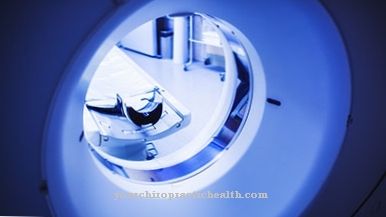A Fire mark or Naevus flammeus is a benign, congenital vascular malformation. The exact cause has not yet been finally clarified. It can also appear along with other diseases. Treatment of a fire mark should be started early. A fire mark can also be an indication of further malformations of the vessels. For example, the vessels of the meninges, but also the bones, can also be affected.
What is a fire mark?

© snapgalleria - stock.adobe.com
A fire mark is a malformation of the smaller skin vessels (capillaries). The malformation is benign and usually congenital. In rare cases, a fire mark can only develop in early childhood.
Fire marks can appear anywhere on the body. There are two types of malformation. The more common form is the symmetrical fire mark. It occurs in 30 to 50 percent of all children and resolves on its own in 70 to 80 percent of cases in the first few years of life. A special form is the so-called stork bite in the neck.
The second, much rarer form is the asymmetrical fire mark. Only around 0.1 to 0.3 percent of newborns are affected. About five percent of asymmetrical fire marks are partial symptoms of other diseases. In these cases there are further malformations of larger vessels or also of the bones or the fatty tissue. The asymmetrical shape can appear anywhere on the body and without treatment, the fire mark will last a lifetime.
causes
The origin of a fire mark has not yet been fully clarified. It is only certain that the malformation is not genetically inherited, provided that it occurs as an individual phenomenon and is not associated with other malformations.
There are widespread rumors, but they are all false. Fire marks are not triggered by a wrong lifestyle on the part of the mother during pregnancy, nor by special events during pregnancy or during childbirth. In rare cases, fire marks occur together with other malformations as part of a clinical picture.
These include Sturge-Weber Syndrome, Proteus Syndrome and Klippel-Treaunay-Weber Syndrome. In these cases there is a genetic link between other malformations of various types and the fire mark.
You can find your medication here
➔ Medicines against redness and eczemaSymptoms, ailments & signs
A fire mark can lead to various complaints and usually also appear in different forms. In general, however, a fire mark always leads to reddened skin, whereby the skin continues to change its color when pressure is applied. In some cases, pain also occurs, so that those affected are restricted in their everyday life.
A fire mark can also significantly limit and reduce the patient's aesthetics, so that most patients with this complaint no longer feel beautiful and also suffer from reduced self-esteem or inferiority complexes. This can also lead to psychological complaints and depression. Furthermore, the complaints also lead to bullying among children or teasing.
Especially on the face, the fire mark can significantly reduce the aesthetics. If the fire mark is near the eyes, it can lead to a cataract and, in the worst case, to a complete loss of vision. Therefore, the fire mark must definitely be treated. Lumps can also form, which can lead to bleeding. However, the life expectancy of the person affected is not negatively affected by the complaint.
Diagnosis & course
A fire mark can be diagnosed based on its appearance without further investigation. However, since fire marks can also occur together with other malformations, the affected children should be examined carefully and precisely.
If the fire mark is in the face area, both brain waves and eye pressure should be measured regularly, as it can also lead to glaucoma (glaucoma). When diagnosing it, it is important to distinguish a fire mark from a blood sponge. In the case of an untreated fire stain, tissue thickening and further vascular dilation develop.
Blackish knots can form, which can burst and bleed. In addition, many of those affected often suffer from severe psychological stress due to their changed appearance. Early diagnosis and treatment of a fire mark is therefore absolutely advisable.
Complications
A fire mark can lead to different complications. These depend on the position and the severity of the symptom. In most cases the affected area of skin is colored red. Likewise, the discoloration of the spot changes when pressure is applied.
If the fire mark is on the face, it must be examined regularly. This can lead to the formation of a green star. Dark knots can also form from the fire mark. These rupture and cause bleeding.
In most cases, the fire marks have a strong negative influence on the psychological situation of the person concerned. Most people don't feel beautiful with the fire mark, which leads to decreased self-esteem. It can also lead to severe psychological problems and depression.
For this reason, early treatment is necessary in order to avoid such consequential damage. A fire mark can, however, be covered with make-up so that there are no further complaints. However, this is not a permanent solution. The fire mark can also be removed with the help of a laser. The removal proceeds without pain and without complications.
When should you go to the doctor?
There are three reasons why it makes sense to consult a doctor in connection with a fire mark. The first case is about identifying possible concomitant diseases that may be related to a fire mark. These include, for example, the Sturge-Weber syndrome, the Proteus syndrome and about two dozen other syndromes that can be associated with the fire mark. A genetic analysis is often necessary for a corresponding clarification. Because the fire mark is noticeable at birth in almost all cases, it is up to the parents to clarify a possible illness.
The second case is about fire marks that are on the face. Because these can change (blood accumulation), regular eye checks are useful, for example. Finally, dilated blood vessels can affect eye pressure and damage the eyes as a result.
The third aspect is an aesthetic one: depending on the location of the fire mark, it can lead to aesthetic and psychological impairments for those affected. In such cases, it may be advisable to go to an appropriately specialized dermatological or cosmetic surgery practice.
Overall, however, the nevus flammeus does not require treatment because it is to be regarded as harmless. He himself will not restrict the person concerned physically or physically. Only possible accompanying circumstances are possible reasons for treatment.
Doctors & therapists in your area
Treatment & Therapy
There are two ways to treat a fire mark. The easiest method is to cover the mark with camouflage or makeup. However, this method is very time-consuming and only brings about a limited improvement.
This is a non-invasive measure, i.e. it does not penetrate the tissue, which only brings about a cosmetic improvement. Covering with camouflage is not only very time-consuming, but must also be learned through expert guidance.
Alternatively, a fire mark can also be removed. This is done through laser therapy. The treatment is carried out with a flash lamp pumped dye laser, known as FPDL for short. Short pulse lengths trigger the bursting or tearing of the small vessels in the area of the fire mark.
Outlook & forecast
The prognosis for a small or large fire mark (nevus flammeus) is not particularly good. Although the fire mark can be harmless, it is usually permanent. This is due to a disturbance in the prenatal formation of blood vessels.
Since a fire mark remains on the skin for life, cosmetic concealment options are a way of dealing with it, at least in the facial area. Since such fire marks are often extensive, bluish or dark red and somewhat raised, they are difficult to conceal inconspicuously. Hence, the chances of making it look less noticeable are limited. The prognosis for laser treatment is not always promising either.
Laser treatment can reduce the size of an extensive fire mark. However, it can often not be completely removed by laser treatment. The prognosis is only more positive for small fire marks. Here, too, there is a certain residual risk that the laser treatment cannot counteract a recurrence of the fire mark. Extensive fire marks on the face in particular can put a lot of psychological strain on those affected. The prognosis therefore also includes the development of social avoidance behavior, depression or a lack of self-esteem.
If the fire mark is part of a Sturge-Weber or Klippel-Trenaunay syndrome, severe damage to the skeleton or blood vessels is the result. Here the prognosis is particularly bad because there are serious medical abnormalities.
You can find your medication here
➔ Medicines against redness and eczemaprevention
So far there are no preventive measures against the occurrence of a fire mark. However, early treatment is advisable to avoid further complications. It is particularly important to avoid mental stress that can arise from an untreated fire mark. These can be counteracted by removing or covering the fire mark early on.
Aftercare
A fire mark cannot be prevented. Therefore, aftercare cannot aim to prevent recurrence. Rather, it is about avoiding complications and making everyday life appear worth living. This is particularly important when laser treatment does not allow complete removal.
Doctors can only try to take the psychological pressure off the patient. Self-esteem can be strengthened in psychotherapy. Remedies for depression and isolation can be discussed there. The use of make-up and make-up is also recommended. Light green color hides the dark red tone of the fire mark.
If the mark can be sclerosed by means of laser technology or if it is located in an inconspicuous place, follow-up care is usually not required at all. Because there is no problem. In this context, however, it is important that the doctor first differentiated the skin appearance from other diseases.
In particular, it must be ensured that no blood sponges are present. This is a tumor. In addition, the males rarely occur with another condition such as Sturge-Weber syndrome and Klippel-Trénaunay syndrome. It is important to have medical evidence that these serious diseases are not involved.
You can do that yourself
In everyday life, there are no physical restrictions from a fire mark, but those affected often feel mentally restricted, especially if the fire mark is on the face. The fire mark can become a burden as soon as it is perceived as a stigma and self-esteem suffers. The problems that come with it can be severe and range up to severe depression. Social isolation and withdrawal into solitude can result.
However, these complications in everyday life arise insidiously, so that they can be counteracted well. It is important to strengthen the self-confidence of those affected in everyday life, to involve them socially and to reduce tendencies towards withdrawal or shame through encouragement, activities and support. Mindfulness and meditation techniques can contribute to self-acceptance, as can regular exercise.
Fire marks can also be covered with special make-up in everyday life. Of course, this is not a permanent solution, but is often perceived as a relief for those affected. The make-up techniques have to be learned first, the procedure itself is time-consuming and the result is not always completely satisfactory. Depending on where a fire mark is located, it can also be covered with clothing in everyday life.






.jpg)



















